不错呦!smile@林凯西,确保“准备文件”中的几个文件都有安装,S...您好,看了您这篇帖子觉得很有帮助。但是有个问题想请...我的修改过了怎么还被恶意注册呢 @jjjjiiii 用PJ快9年了,主要是A...PJ3啊,貌似很少有人用PJ了,现在不是WP就是z...@332347365,我当时接入时错误码没有-10...楼主,ChkValue值应为-103是什么意思呢?...大哥 你最近能看到我发的信息,请跟我联系,我有个制...
SQL Server2000:ROLLUP和CUBE运算符使用
编辑:dnawo 日期:2010-04-16
ROLLUP、CUBE运算符和GROUP BY一起使用能在结果集中加入一些额外的统计信息,例如有一张OrderDetail表,结构和数据如下:

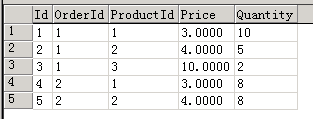
例1:统计每个订单的产品数量。
结果集:
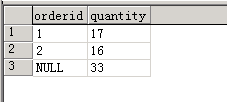
如图所示,ROLLUP统计出了所有订单的产品数。
例2:统计每个订单、每种产品的数量。
结果集:

如图所示,ROLLUP统计出了每笔订单的产品数以及所有订单的产品数。
例3:统计每个订单、每种产品的金额。
结果集:
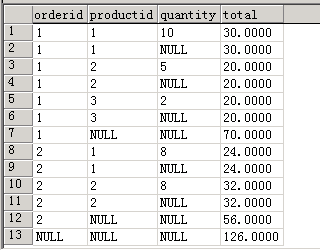
如图所示,ROLLUP统计出了每笔订单的金额以及所有订单的金额。
例4:当GROUP BY后边有多个字段时,字段的前后顺序不同,结果就会不同,用例2做测试。
结果集:
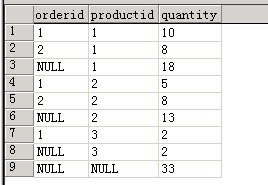
小结
·ROLLUP得紧跟在GROUP BY后边使用;
·GROUP BY后边字段的前后顺序影响ROLLUP的结果;
·ROLLUP将GROUP BY后边字段从右到左依次为NULL再汇总其他聚合列的值;
例5:再以例2为例,CUBE运算符结果为例2和例4结果集的并集。
结果集:

小结
·和ROLLUP运算符不同的是CUBE运算符不受GROUP BY后边字段的前后顺序的影响,CUBE运算符将GROUP BY后边字段排列组合设置为NULL再汇总其他聚合列的值;
GROUPING函数
GROUPING函数可以判断列的值是否是ROLLUP、CUBE运算符生成的,若则则函数值为1,否则为0。再来看一个例子:
结果集:
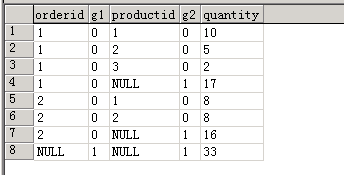


例1:统计每个订单的产品数量。
复制内容到剪贴板 程序代码
程序代码
 程序代码
程序代码select orderid,sum(quantity) as quantity from orderDetail
group by orderid
with rollup
group by orderid
with rollup
结果集:

如图所示,ROLLUP统计出了所有订单的产品数。
例2:统计每个订单、每种产品的数量。
复制内容到剪贴板 程序代码
程序代码
 程序代码
程序代码select orderid,productid,sum(quantity) as quantity from orderDetail
group by orderid,productid
with rollup
group by orderid,productid
with rollup
结果集:

如图所示,ROLLUP统计出了每笔订单的产品数以及所有订单的产品数。
例3:统计每个订单、每种产品的金额。
复制内容到剪贴板 程序代码
程序代码
 程序代码
程序代码select orderid,productid,quantity,sum(price*quantity) as total from orderDetail
group by orderid,productid,quantity
with rollup
group by orderid,productid,quantity
with rollup
结果集:

如图所示,ROLLUP统计出了每笔订单的金额以及所有订单的金额。
例4:当GROUP BY后边有多个字段时,字段的前后顺序不同,结果就会不同,用例2做测试。
复制内容到剪贴板 程序代码
程序代码
 程序代码
程序代码select orderid,productid,sum(quantity) as quantity from orderDetail
group by productid,orderid
with rollup
group by productid,orderid
with rollup
结果集:

小结
·ROLLUP得紧跟在GROUP BY后边使用;
·GROUP BY后边字段的前后顺序影响ROLLUP的结果;
·ROLLUP将GROUP BY后边字段从右到左依次为NULL再汇总其他聚合列的值;
例5:再以例2为例,CUBE运算符结果为例2和例4结果集的并集。
复制内容到剪贴板 程序代码
程序代码
 程序代码
程序代码select orderid,productid,sum(quantity) as quantity from orderDetail
group by orderid,productid
with cube
group by orderid,productid
with cube
结果集:

小结
·和ROLLUP运算符不同的是CUBE运算符不受GROUP BY后边字段的前后顺序的影响,CUBE运算符将GROUP BY后边字段排列组合设置为NULL再汇总其他聚合列的值;
GROUPING函数
GROUPING函数可以判断列的值是否是ROLLUP、CUBE运算符生成的,若则则函数值为1,否则为0。再来看一个例子:
复制内容到剪贴板 程序代码
程序代码
 程序代码
程序代码select orderid,grouping(orderid) as g1,productid,grouping(productid) as g2,sum(quantity) as quantity from orderDetail
group by orderid,productid
with rollup
group by orderid,productid
with rollup
结果集:

 上一篇: 使用SQL Server2000关系图管理表
上一篇: 使用SQL Server2000关系图管理表 下一篇: SQL Server2000:COMPUTE函数
下一篇: SQL Server2000:COMPUTE函数 文章来自: 本站原创
文章来自: 本站原创 Tags:
Tags:  最新日志:
最新日志:
评论: 0 | 引用: 0 | 查看次数: 5298
发表评论
请登录后再发表评论!





